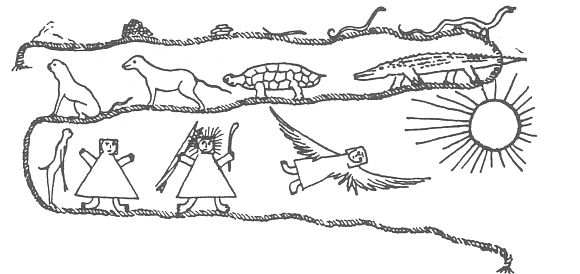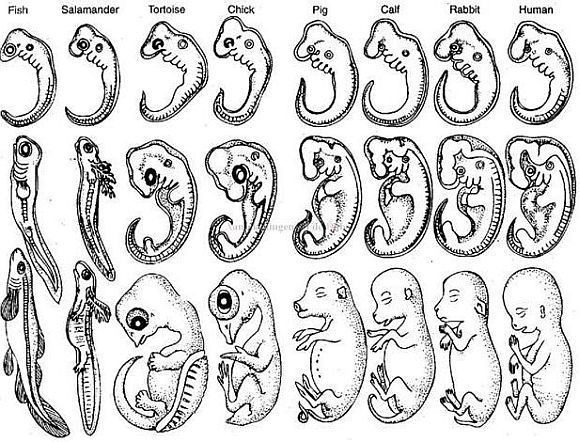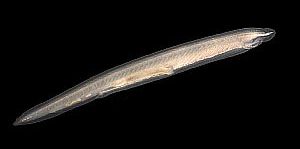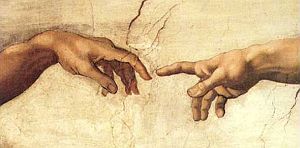
The embodiment of man was not prepared
by the uprising of the human body.
The body rose up,
as the form became human.
Louis Bolk
Evolution: a different view
Evolution or Creation
Do you believe in evolution or in Creation? Are you in favour of the one or the other? What is your persuasion? It seems as if there is a religious conflict about evolution.
People who believe in Creation are called creationists, they challenge - and are opposed to the neo-Darwinian evolution theory. Supporters of the evolution theory think of themselves as scientific. And yet, the biologist Richard Dawkins - supporter of the evolution theory - says:
"You cannot be both sane and well educated and disbelieve in evolution. The evidence is so strong that any sane, educated person has got to believe in evolution."
When the evidence is so strong, then why should one have to believe? Why should someone who does not believe in evolution be insane? Should not a demonstration of the evidence be enough to convince? Is the evidence as strong as proponents claim?
Evolution describes the succession of species that have populated the earth and now live on it, and gives a theory ("survival of the fittest") of how this happened. That is science, according to Kim Meijer (see: Introduction to evolution). Opposed to evolution is Creation, as described in the Bible, where God created the earth, plants, animals and man in six days. A belief, an assumption, impossible to prove. Before Darwin formulated his theory of evolution and changing species, this was the dominant way of thinking, in which species are unchanging.
The Inca fresco pictured below shows that an unchanging world has not always and everywhere been man's premise. On a line (which can be interpreted as a time line) an evolution is depicted. In the beginning we see an amorphous mass, then there are stacks of cells, followed by a worm, a snake and other reptiles, a mammal, another mammal straightening up a little, an almost upright monkey (with a short tail and long arms) and then a man, a man with tools, and finally an angel flying to the sun. The people are shown as a stylized triangle, which perhaps points to the threefoldness of man.

An Inca fresco, which shows the evolution from unicellular organisms via reptiles and mammals
to man and an angel.
The problem does not seem to be that evolution has occurred, but how. Is it a blind process or is there a purpose in evolution?
Intelligent design
There is a third way, viz. intelligent design, that says that plants and animals are best explained by an intelligent cause, and not by a blind process like natural selection. This theory assumes evolution and a spiritual guiding force or a spiritual being, which is not named, and may be God or another being. Intelligent design avoids naming the intelligent designer, and gives no explanatory theory of evolution.
Intelligent design gives two arguments for a spiritual guiding force:
- Organisms are very complicated. When an organ or a process is removed from an organism, it does not function anymore. This is called "irreducible complexity". The development of speech (see: Man and the chimpanzee) is an example.
- It also refers to the "specified complexity". DNA is an example of this: its elements are simple, but the whole is complex and has complex effects. Both can only arise and be directed from a higher point of view, according to intelligent design.
Because the theory gives no explanation on how species evolve, it does not clarify much in terms of understanding evolution.
Criticism
Creationists reject evolution. Intelligent design does not reject the principle, believes that evolution is guided and not blind, but gives no explanation. There is other criticism of neo-Darwinism. Some examples:
Punctuated equilibrium
Neo-Darwinism predicts that species gradually change by mutations, so called phyletic gradualism. If that is the case, there should be transitional forms from one species to another. These transitional forms are not found in fossils. A species is found and then another that is significantly different from the first in several characteristics and stable - with minor variations. This has been a point of criticism for a long time. Stephen Jay Gould explains it by evolution through abrupt changes, called punctuated equilibrium.
Punctuated equilibrium states that species don't change for a long time and then change dramatically in a relatively short period of time (several thousands - to hundreds of thousands of years) Because of this rapid change, transitions between species are very rare. Research shows that these abrupt changes occur, e.g. in the evolution of the horse.
An interesting aspect of punctuated equilibrium is, that natural selection is seen as a brake. As long as the environment does not change, selection sees to it that species vary but don't change. However, once a major change in the environment occurs, the brake is released and species can change dramatically in a short time, because mutations are no longer immediately eliminated.
Gould puts it like this:
"No one denies that natural selection will play a negative role in eliminating the unfit. Darwinian theories require that it create the fit as well."
Cooperation and symbiosis
Is competition the driving force for evolution? Or could it also be co-operation? Lynn Margulis is in favour of the last opinion. She has discovered that mitochondria, the energy-producing organs of plant- and animal cells, probably result from the association or symbiosis of two formerly separate single-celled organisms: a host cell and a bacterium which has moved in as a mitochondrion. This also applies to chlorophyll. Symbiosis thereby seems essential for the course of evolution.

An example of symbiosis. A free living bacterium is taken inside a cell, functions as a mitochondrion and takes care of the energy supply of the cell.
An example on a different level: Plants need nitrogen, but cannot convert it efficiently, whereas bacteria can. On and around the roots of many species of trees there are fungi that form a suitable environment for bacteria which are able to convert nitrogen into a form that can be absorbed by trees. In return, the trees give the fungi sugars to grow. The roots of the trees, fungi and bacteria (collectively called mycorrhiza) all create the conditions for each other's growth. Instead of competing for scarce resources, they work together to produce enough nitrogen.
Another example: in a human being there are twenty times more viable bacteria alive than human cells. 90% of the dry weight of human waste consists of remnants of intestinal bacteria. Humans and animals can digest a wide range of nutrients, because of the many symbiotic partnerships with a wide range of micro-organisms.
Blind evolution
The main point seems to be that Neo-Darwinism sees evolution as a blind process, which, quite accidentally, happened to result in the speaking, thinking human being. On the Introduction evolution page, evolution biologist Kim Meijer was quoted. Here is a quote from Richard Dawkins:
"Natural selection, the blind, unconscious automatic process which Darwin discovered, and which we now know is the explanation for the existence and apparently purposeful form of all life, has no purpose in mind. It has no mind and no mind's eye. It does not plan for the future. It has no vision, no foresight, no sight at all."
This vision is expressed in many ways. Also in the way in which the evolution tree is depicted. In an old pedigree made by Ernst Haeckel, man is at the top. On a modern one, man is no longer shown, he is classified with the monkeys. It is no longer a tree striving upward, but it has a rounded crown and all species are of the same rank. Formerly man was at the end and he was seen as highly developed, now he is a monkey among the monkeys and an animal among the animals. Haeckel's tree shows a continuous main trunk that ends in humans and branches that lead to the animals. Such a trunk with branches can also be found hidden in the modern circular tree.

An old-fashioned evolution tree (Ernst Haeckel). The main trunk leads to man, animals form the branches.
In the following sections, the evolution of man and animals will be discussed. The data of the previous pages will be used.
The evolution of man
Unlike animals, man is not specialized. Animals are, they are adapted to their environment. Man adjusts his environment to his needs. The physique of man is of a general nature. Jos Verhulst explains man from two processes (see: Man and the chimpanzee):
- Man largely maintains the fetal form and says no to specializations and
- Man develops for a long time and does this slowly.
The first process is described by Louis Bolk, the second by Jos Verhulst. They are discussed on the page Man and the chimpanzee. Both processes take place in the embryo and the fetus and come from within the organism. They cannot be adaptations to external circumstances. They are already present in the embryo and the fetus of a previous species, e.g. a chimpanzee, before they come to expression in the next one, e.g. in man.
Neoteny
The first process is called neoteny or juvenilization. Neoteny is the retention by adults of traits previously seen only in embryo's or juveniles. This is a widely recognized phenomenon. In fact, the emergence of vertebrates was caused by neoteny.
Tunicates are the animals that are closest to the vertebrates. They live in the sea. As adults they are attached to the bottom and they feed themselves by filtering food from the water. Their larvae swim freely. These larvae have a notochord and a hollow nerve channel similar to the embryo's of vertebrates. Probably some larvae matured before metamorphosis to the sedentary life form took place and they continued to swim as adults with a notochord. Such a creature still exists - it is the lancelet. From this the vertebrates evolved. The adult tunicates lose the notochord and the nerve channel. So, organs develop in the larva that disappear in the metamorphosis to the adult but are crucial for organisms that evolve later on.

An adult tunicate. Notochord and nerve channels have disappeared.
Apes retain more juvenile characteristics than the old world monkeys and they again more than de monkeys from the new world. The bonobo is closer to humans than the common chimpanzee, retains more juvenile characteristics and is therefore neotener. The closer to man, the more juvenile features are retained.
Like the chimpanzee, that first has its foramen magnum right in the middle of the underside of the skull, the tunicate first has a notochord, which has no significance for it and which it loses. Its retention led to the vertebrates, just like the retention of the position of the foramen led to man. At first the feature is developed and gets lost, in the next species it is retained and shows its significance.

Embryo's of different animals. In the first stage, all embryos resemble those of humans, the more akin the stronger. In the second row those of mammals still quite resemble man. The fetuses are all different.
Internal development factor
In his observations on the human-like growth of hair on the head of the chimpanzee in 1918 in Hersenen en cutuur (Brains and Culture), Louis Bolk wrote:
"But how can it be that a physical characteristic, acquired by man during his incarnation, asserts its influence on the individual development of the chimpanzee?
The fetal characteristics that we highlight here cannot be the result of an adaptation to external circumstances, because chimpanzees with a naked body and a hairy skull have never existed, nor did any of their ancestors have such characteristics. The phenomenon must be a manifestation of a deeper evolutionary principle.
Thus we come to the important conclusion that the causes leading to the loss of hair in humans and the retention of hair on his scalp, were already active in the development of the fetus of apes. Therefore the causes cannot be of an external nature, nor can it be that their first manifestation and influence arose when man incarnated. It must have been an internal development component, rudimentary active in apes, unfolding its full power in humans.
Thorough reflection on this point of view must lead to the opinion, that in the most primitive organism the necessity of the incarnation of man was already contained. The one had to follow from the other in the course of time, as from a fertilized animal egg an adult animal must emerge.
I am fully aware of the fact that with this conclusion I am skating on thin ice. Because I expose myself to the observation, that with the introduction of an internal development factor - located in the organism itself and partly responsible for the appearance and the changes in the shape of animal forms in the course of time - I will have to consider the evolutionary process as something a priori determined, as something given from the inside. This observation is correct, but does not change my point of view."
Soft evolution
The evolutionary development that leads to man is one that retains fetal and juvenile characteristics and allows the embryonic and juvenile development to last longer and longer. Thus man keeps his flat face and erect head and develops long legs and large brains. By the same neoteny process, the vertebrates evolved. If one follows the trail further back, according to Bolk, it was predisposed in the first unicellular organism that man should appear at the end of the development. At the beginning of the evolutionary development man must already have been "imagined". After the beginning, the two earlier described processes lead to him. The first to be conceived, the last to appear: "The first will be the last"? A blind process this is definitely not.
Of this development over billions of years no fossil traces have been preserved, because it took place in the soft tissues of the embryo.
The evolution of animals
In contrast to humans, animals did specialize and in the course of the evolution the specialization increased, as the example of the evolution of the horse shows. Animals closer to humans, such as the chimpanzee, are less specialized than animals further away from him. In their embryonic development, sooner or later animals need to break down the long development to the human form in order to be able to specialize. The further away from humans, the earlier the development is broken down and the more specializations can be inserted. This is why Bolk called the development of the animals accelerated in relation to humans.
A box filled with wooden blocks
Jos Verhulst uses the metaphor of a box filled with wooden blocks to clarify this:
"In comparison, one could consider a set of differently shaped wooden building blocks which fit neatly and closely in their box. Take the blocks out of the box and replace one of them by another block of equal volume but different shape. Try to insert this new set in the box. This will be impossible. One will have to give up one or more supplementary blocks, and the final fitting will be loose and in a sense miss the inner consistence and uniqueness of the original set.
On the one hand refitting the changed set of blocks will take less time (there is 'acceleration' of a kind, since there are not so many blocks to insert), on the other it will not result in a perfectly fitting pattern.
The later developmental stages correspond to the upper layers in the box. Replacement of a block in one of the upper layers will not affect the snugly fitting blocks in the lower layers, but supplanting a block in the lowermost layer will generally result in breaking up the original fit through most of the box. Introduction of a strange (or 'specialized') block in the upper layers is less disturbing and less costly in terms of overall coherence."
And: "The comparison with the blocks illustrates clearly the relationship between the long human development time and the unspecialized nature of the human organism. Bolk's theory predicts that the development of an animal in the early stages will pass more human-like, in the later stages it will deviate more and more from the original shape. Simultaneously the theory predicts that specializations occurring in the animal will lead to inconsistencies in the organism."
Hard evolution
Animals evolve in interaction with their environment. Ungulates and grasses evolved jointly. Ungulates were increasingly capable to digest grass through various adaptations of their digestive tract and their teeth, and grasses were increasingly capable to endure grazing because they brought their growing point close to the ground and were better capable to shoot after grazing.
The bones, skeletal remains, animal tracks and other traces are preserved in strata and so the development of animals can be followed. This is hard evolution, evolution in bone.
The giraffe
The long neck and legs of the giraffe cannot be explained as adaptations. If there were an internal development factor in the giraffe, what would it look like? I will have a try.
First some characteristics. The giraffe is the largest of all true ruminants. With a weight of 1200 kilos it weighs more than the bulls of cattle, bison or buffalo (1000 kilos). The giraffe selects its food with its long tongue and sensitive lips and ruminates most of the day. It is focused on its metabolism.
Its environment is the plain. A giraffe has large eyes and ears and is attentive and focused on its surroundings. This is possible because the head - on the long neck - is far away from the digestive processes of the rump. Therefore, it is beyond the influence of the introspective metabolic processes. Interestingly, in the range of horse - dromedary - giraffe, the animals are increasingly directed towards their metabolism and the length of the neck increases, which is necessary in order to have attentive senses. The length of the legs increases, too, apparently these two lengthening processes go together.
A giraffe is long because of its long neck and long legs; the length of the trunk is relatively short. The body slopes down to the posterior, for which shortening protrusions of the vertebrae, together with the sloping backbone, are responsible. The front legs are long compared to the hind legs, the toes are extra long, and the hooves extra large. The cervical vertebrae are long, the vertebrae of the backbone are not. The jaw is long in relation to the skull. Not only long but also slender are words that belong to the giraffe: a slender body, a slender head, a slender jaw. Of the digestive tract the esophagus and colon are extra long and the rumen is relatively small for a ruminant.
It is obvious that it are the body parts, which develop early in the embryo, that lengthen. This applies to the esophagus and the colon (the digestive tract arises from the ends), the cervical spine, the jaw, the front legs (develop earlier than the hind legs), the toes and hooves (develop earlier than the lower and upper legs).
It seems that embryonic growth processes start strongly, but don't continue for long. The powerful impetus of the digestive tract produces a long mouth and a long esophagus in interaction with the bones of the jaw and the neck. The sloping back is caused by the long front legs and through the diminishing protrusions. Processes that start strong and are not sustained.
The giraffe combines a large body with high alertness. It is a large animal focused on the metabolism and with large senses. To be attentive, the head has to be far away from the rump. This requires a long neck. That seems to me the development factor: a large, attentive metabolism-limb animal. The long neck is needed to achieve this and therefore the key to understand the giraffe.
Threefoldness
With the giraffe I don't see a blind process. But there is more order to be observed. Why do we see a threefold structure in groups of animals, that starts with small, nervous, sensorial active animals with posterior emphasis, then predatory animals without bodily emphasis, and then large gregarious animals that are able to eat badly digestible food?
When this is found once, it may be a coincidence, but if it is found in mammals (details) dinosaurs (details) and birds (see opposite and below) one can no longer speak of a blind and random process. There must be an internal development factor and a directed process in animal evolution. The occurrence of rodents necessarily leads to the emergence of predators and ungulates. Horses cannot exist without tapirs and rhinos, antelopes not without sheep and cattle. Animals always show a threefold structure, together forming a super-organism. The nerve-sensory area, the heart-lung area and the metabolic-limb area are specializations of animals on different levels, integrated in humans (details).
Threefoldness of birds
Nerve-sense: songbirds: small, posterior emphasis (long tail), seed - and insect eaters
Heart-lung: birds of preys, no emphasis, carnivores
Metabolic-limb: anterior emphasis (long neck, head ornaments), long-legged, grass eaters
Similarities in colour and pattern of birds and mammals


Nerve-sense animals: light coloured underside, coloured upperside: willow warbler and house mouse


Heart-lung animals: spotted pattern: kestrel and ocelot


Metabolic-limb animals: uniformly dark coloured and head ornaments: cassowary and African buffalo

Michelangelo's Creation of Man

Above: phyletic gradualism, below: punctuated equilibrium.
In phyletic gradualism, species change constantly and are not stable, it's hard to tell where one species ends and another begins. In punctuated equilibrium, species are stable for a long time and a new species is found after a relatively short time.

Mycorrhiza: co-operation of plant, fungi and
bacteria to mutual benefit

A modern evolution tree. Man is a monkey among monkeys and an animal among animals. There is no higher or lower development. This view is due to
the "belief" (Dawkins) in blind chance.
Partly based on:
- Jos Verhulst, Developmental dynamics in humans and other primates, 2005, Floris Books, Edinburgh.
Citations from:
- Jos Verhulst, Louis Bolk revisited: 1. Is the human lung a retarded organ?, 1993. Medical Hypotheses, 40 (331-340).
- Jos Verhulst, De menselijke voorvader van de aap. Interesse, z.j.

A colony of tunicates

Larva of a tunicate with a notochord and a hollow nerve canal.

A lancelet fish, a descendant of animals arising from the larva of a tunicate, which grew into an adult and retained its notochord and nervous canal.

The evolution is put into motion

Skeleton of a giraffe
From the Nature Institute: more on the giraffe
Threefoldness of birds

Trajectory of the plumage pattern of birds and their morphological characteristics. It is seen in the same way at lower taxonomic levels. The patterns are, from left to right: underside light, upperside dark; horizontally striped; mottled, dull or mixed; vertically striped; strict segregation of black and white or uniformly dark; and underside black, upperside white. This corresponds to the trajectory of the pattern in mammals.
Source: Mark F. Riegner, 2008. Parallel Evolution of Plumage Coloration and Pattern in Birds: Implications for Defining Avian Morphospace. The Condor 110 (4): 599-614.
